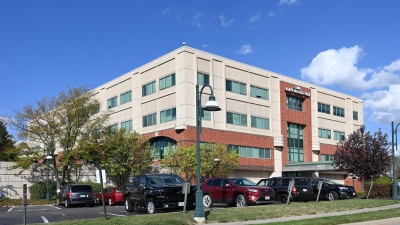Pelvic Congestion Syndrome
Pelvic congestion syndrome is a condition that causes chronic pelvic pain. It's thought to be caused by problems with the veins in the pelvic area. This is the lower part of your belly (abdomen).
What is pelvic congestion syndrome?
Pelvic congestion syndrome is a condition that causes chronic pelvic pain. It's thought to be caused by problems with the veins in the pelvic area. This is the lower part of your belly (abdomen).
Veins are the blood vessels that carry blood back to the heart. In some people, veins in the lower abdomen may stop working well. Blood may start to build up inside the veins. When this happens, the veins in your pelvis can enlarge and change shape, like varicose veins. This may lead to the pain and other symptoms of pelvic congestion syndrome.
It happens mostly in people of childbearing age. It may be more common in people who have given birth to more than one child.
What causes pelvic congestion syndrome?
Healthcare providers are trying to understand the possible causes of pelvic congestion syndrome. Enlarged veins in the pelvis seem to play a major role. But many people have enlarged veins and no symptoms. Pregnancy may increase the risk for pelvic congestion syndrome. This is because veins enlarge during pregnancy to support the increased blood flow. This can permanently enlarge the veins and lead to symptoms.
Hormones may also play a role in pelvic congestion syndrome. Estrogen makes veins wider (dilates). This may be why the condition is not common after menopause. Estrogen levels are lower after menopause. Other hormones may also cause veins to grow wider and cause symptoms.
Who is at risk for pelvic congestion syndrome?
You may have a higher risk for pelvic congestion syndrome if you have given birth to more than one child. You may also have a higher risk if other members of your family have it.
What are the symptoms of pelvic congestion syndrome?
The main symptom of pelvic congestion syndrome is pelvic pain that lasts at least 6 months. This pain often first starts during or after a pregnancy. It may get worse after a later pregnancy. The pain may be a heavy or aching feeling. Or the pain may be sharp. Usually the pain is only on one side, usually the left side. At times you may feel it on both sides. The pain is often worse at the end of the day.
Certain factors may make the pain worse, such as:
Changing your posture
Having sex (both during and after)
Standing for a long time
Walking
Some people also have symptoms, such as:
Pain before or during their periods
Feeling a sudden need to urinate
Enlarged and distorted veins on the buttocks, external genitals (vulva), or thighs
How is pelvic congestion syndrome diagnosed?
Pelvic congestion syndrome is not easy to diagnose. Pelvic pain is common and there are many different causes. Pelvic pain can result from problems with the reproductive system, like your ovaries and uterus. It can be caused by the urinary system, like your bladder. It can be caused by the gastrointestinal system, such as your large intestine. And it can be caused by muscles or bones. Mental health conditions such as depression are also linked to chronic pelvic pain. Your healthcare provider will need to consider many possible causes before diagnosing the condition. Pelvic congestion syndrome is suggested by finding enlarged pelvic vessels by ultrasound or venography.
Your healthcare provider or an OB/GYN healthcare provider may diagnose the condition. They will ask about your health history and your symptoms. You will also have a physical exam. This will likely include a pelvic exam.
You may also need some tests, such as:
Urine tests to check for problems with your urinary system
Blood tests to check for pregnancy, sexually transmitted infections (STIs), anemia, and other conditions
Pelvic ultrasound to look for growths in the pelvis
Doppler ultrasound to check the blood flow in the pelvic blood vessels
CT scan or MRI for more detailed pictures
Diagnostic laparoscopy to rule out other causes of pelvic pain
A procedure to take X-rays of the pelvic veins (venography)
How is pelvic congestion syndrome treated?
Your healthcare provider can tailor your treatment according to your symptoms. Possible treatment options include:
Gonadotropin-releasing hormone drugs, which block ovarian function and may relieve pain
Progestin hormone drugs, which may relieve pain
Procedures to shut off damaged veins (sclerotherapy, embolization)
Surgery to remove damaged veins
Surgery to remove your uterus and ovaries
Your healthcare provider may suggest starting medicines. If these don't relieve your symptoms, your healthcare provider may advise a procedure to treat the condition. Your symptoms may ease up as you enter menopause.
When should I call my healthcare provider?
If your symptoms get worse, plan to see your healthcare provider soon. Pelvic congestion syndrome itself doesn't usually lead to a medical emergency. If you have a sharp, sudden pain that doesn’t go away, see your healthcare provider right away.
Key points about pelvic congestion syndrome
Pelvic congestion syndrome is a health condition that causes chronic pelvic pain. The condition is thought to be caused by the enlarged veins in your pelvic area.
People of childbearing age who have had more than one pregnancy may have the highest risk for pelvic congestion syndrome.
Pelvic pain is the main symptom. This may get worse after standing, walking, or having sex. It may start during or after pregnancy.
You may need several tests to rule out other causes of pelvic pain.
Hormone treatments may help symptoms.
Procedures that block the damaged veins (embolization) or surgery to remove the ovary and tube or the uterus may be choices.
Next steps
Tips to help you get the most from a visit to your healthcare provider:
Know the reason for your visit and what you want to happen.
Before your visit, write down questions you want answered.
Bring someone with you to help you ask questions and remember what your healthcare provider tells you.
At the visit, write down the name of a new diagnosis, and any new medicines, treatments, or tests. Also write down any new instructions your provider gives you.
Know why a new medicine or treatment is prescribed, and how it will help you. Also know what the side effects are.
Ask if your condition can be treated in other ways.
Know why a test or procedure is recommended and what the results could mean.
Know what to expect if you do not take the medicine or have the test or procedure.
If you have a follow-up appointment, write down the date, time, and purpose for that visit.
Know how you can contact your healthcare provider if you have questions, especially after office hours or on weekends and holidays.
Locations

Saint Luke's Women's Health North

Hedrick OB-GYN Associates

Saint Luke’s Hospital Plaza OB-GYN Clinic

Saint Luke’s Women’s Health East

Saint Luke’s Women’s Health South

Saint Luke’s Hospital Medical Education OBGYN Clinic
